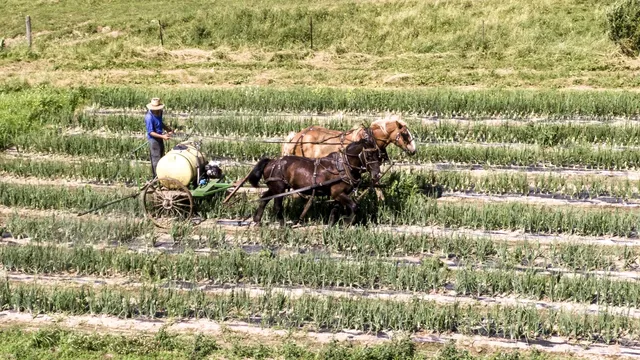But one group appears to be practically immune, which is a mystery to allergy experts.
Despite the growing prevalence of allergic diseases in both industrialized and developing countries, the Amish remain remarkably—and inexplicably—resistant.
Only 7% of Amish children had a positive reaction to one or more common allergens in a skin test, compared to more than half of the general US population.
Even children from other traditional rural families, who still have lower rates of allergic diseases than children who do not live in rural areas, are more allergic than the Amish, according to an article in The Washington Post.
In fact, an Amish community living in northern Indiana is considered one of the least allergic populations ever measured in developed countries.
"Overall, across the country, about 8 to 10% of children suffer from asthma. Among Amish children, the rate is probably 1 to 2%," says Carol Ober, chair of the Department of Human Genetics at the University of Chicago.
"A few of them have allergies, but at much lower rates than the general population," she adds.
Now Ober and other researchers are trying to find out what makes the Amish and other traditional farming communities unique, with the hope of developing a protective treatment that can be used in young children.
For example, a probiotic or essential oil containing substances found in agricultural dust, such as microbes and the molecules they produce, could stimulate children's immune systems in a way that prevents allergic diseases.
"Some types of agricultural practices, especially the very traditional ones, have this remarkable protective effect in the sense that asthma and allergies are virtually unknown in these communities," explains Donata Vercheli, professor of cell and molecular medicine at the University of Arizona.
"Studies conducted among these farming populations are crucial because they show us that protection is an achievable goal."
The Amish are members of a Christian group that practices traditional agriculture—many of them live on single-family dairy farms—and use horses for field work and transportation.
As of 2024, there are approximately 395,000 Amish living in the United States, concentrated primarily in Pennsylvania, Ohio, and Indiana.
Over the past century, the incidence of allergic diseases—including hay fever (allergic rhinitis), asthma, food allergies, and eczema—has increased dramatically.
Hay fever, or an allergic reaction to pollen from trees, grass, and weeds, emerged as the first recognized allergic disease in the early 19th century, reaching epidemic levels in Europe and North America by 1900.
In the 1960s, there was a sharp increase in the prevalence of asthma in children, a condition in which the airways constrict when an allergen is inhaled.
Since the 1990s, developed countries have seen a rise in food allergies, including allergies to cow's milk, peanuts, and eggs.
Urbanization, air pollution, changes in eating habits, and a sedentary lifestyle are often cited as possible factors.
The "hygiene hypothesis," first proposed in a study by American immunologist David Strachan in 1989, suggests that exposure to microbes in early childhood protects against allergic diseases by contributing to the development of a healthy immune system.
The study found that hay fever and eczema were less common among children born into larger families. Strachan wondered whether unhygienic contact with older siblings served as protection against allergies.
Subsequent findings support the hygiene hypothesis, such as that children who grow up with more pets are less likely to develop asthma, hay fever, or eczema.
However, it is possible that even more beneficial than having older siblings or pets is growing up on a farm.
(More than 150 years ago, hay fever was known as the "aristocratic disease," almost entirely confined to the upper classes. Farmers seemed relatively immune.)
This "farmer effect" has been confirmed by studies of agricultural populations around the world, including in the United States, Europe, Asia, and South America.
But even among rural communities, the most pronounced effect is seen among the Amish. In a study of 60 students conducted by Ober, Vercheli, and their colleagues, the prevalence of asthma was four times lower among the Amish than among the Hutterites, another farming community in the US with similar genetic origins and lifestyles.
The prevalence of allergic sensitization—the development of antibodies to allergens and the first step toward developing allergies—was six times higher among the Hutterites.
The researchers first ruled out a genetic cause; in fact, analysis showed that Amish and Hutterite children were extremely similar in terms of their ancestry.
Instead, the main difference between these two populations appeared to be the degree of exposure to farm animals or barns in early childhood.
"Hutterite children and pregnant women do not enter barns. Children are not exposed to animals in barns until they are about 12 years old, when they begin to learn farm work," Ober said.
"Amish children go in and out of the barns all day long from an early age," the researcher added.
When analyzing samples of household dust from the Amish and Hutterites, they found nearly seven times higher microbial loads in Amish homes.
Later experiments showed that the airways of mice that inhaled Amish dust had significantly fewer asthma symptoms when exposed to allergens.
Mice that inhaled Hutterite dust did not have the same effect.
Now Ober and Vercheli are beginning to identify the protective agents in Amish dust that prevent allergic asthma.
In 2023, their analysis of farm dust discovered proteins that act like delivery trucks loaded with molecules produced by microbes and plants.
When these transport proteins deliver their cargo to the mucus lining the airways, a protective environment is created that regulates airway responses and prevents inflammation.
"We don't talk so much about the hygiene hypothesis anymore because we now understand that it's not really about how hygienic you live," said Kirsi Järvinen-Sepo, director of the Center for Food Allergy Research and Education at the University of Rochester Medical Center.
"It's more of a microbial hypothesis, as the beneficial bacteria that colonize the gut and other mucous membranes play an important role," the expert added.
During the first year or two of life, a baby's immune system develops rapidly and is highly susceptible to environmental stimuli such as bacteria.
Some experts believe that exposing young children to certain types of beneficial bacteria may activate and shape the developing immune system in a way that reduces the risk of allergic diseases later in life.
Farm dust contains a mixture of bacteria from domestic animals and animal feed that are not harmful enough to cause disease but effectively train the immune system to respond less strongly to allergens later in life.
In 2021, Kirsi Järvinen-Sepo and her colleagues compared the gut microbiomes of 65 babies from an Old Order Mennonite community in rural New York with 39 babies from urban/suburban areas in nearby Rochester.
Like the Amish, the Old Order Mennonites lead a traditional agrarian lifestyle.
Nearly three-quarters of the Mennonite babies in the study were colonized with B. infantis, a bacterium associated with lower levels of allergic diseases, compared with 21% of the babies in Rochester.
"The colonization rate is very low in the US and other Western countries compared to the very high levels in Mennonite communities, similar to some developing countries," she said.
"This reflects the prevalence of autoimmune and allergic diseases."
These clues about the origins of the farm effect represent a step toward preventing allergic diseases.
Regardless of the form of treatment, the impact on preventing allergic diseases, which affect millions of people worldwide and reduce quality of life, could be enormous, experts say.
"I don't know if we can give every family a cow. ... But from these long-standing and very stable environments, we are learning what substances and exposures are necessary," Vercheli said.
"Once we understand that, I don't think there will be any obstacles to developing protective strategies in this direction," she concluded. | BGNES

 Breaking news
Breaking news
 Europe
Europe
 Bulgaria
Bulgaria







